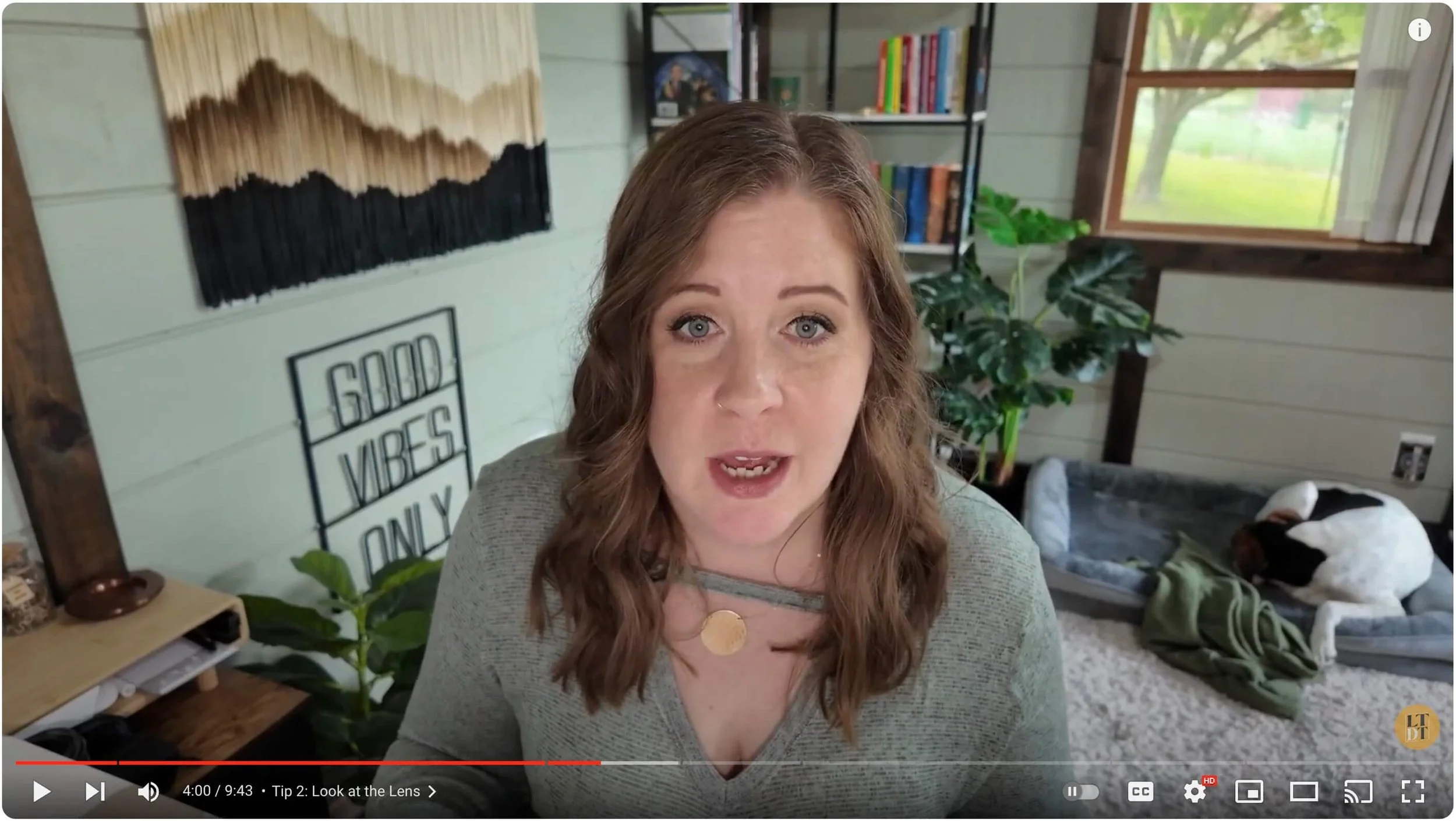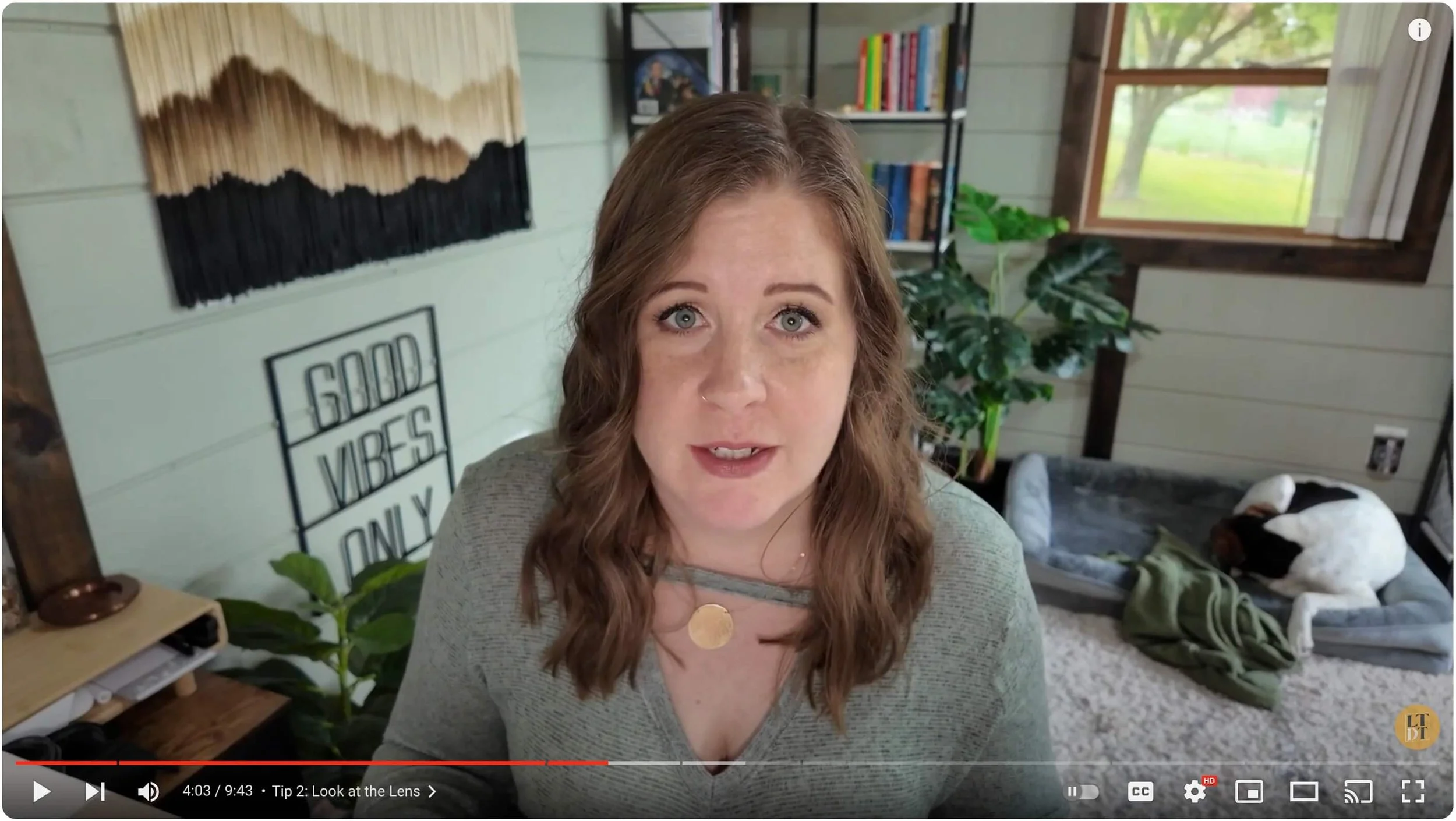3 tips to help get comfortable on camera
What's inside this post: Hide
Today I’m sharing two or three of my best tips to help you get comfortable talking and being on camera. They're not mind-blowing or scary or complicated, I promise. These are just the 3 things I did, which landed me here. That's it! Nothing crazy; no courses or software or equipment that you have to go out and buy.
But before I dive into those, if we haven't met, my name is Katelyn and I'm a Squarespace web designer turned Educator. Now I'm sharing stuff like this for people who want to know how I ended up here, ––being an introvert on YouTube–– because that's a good question!
Let's dive in.
Tip 1: Practice Makes Perfect
The first tip to get comfortable on camera… is to practice. I know; what a novel concept!
Most people are not out of the box (that is to say, born with) the innate ability or are naturally inclined to show up on camera, comfortably. Those of us who that doesn't come naturally to, just have to practice and get better at it.
It is weird to be here in my office, in my house alone, at this moment (besides the fur babies who are clearly distraught that I am talking to apparently no one) sitting at my desk talking to no one. But I am looking at the camera lens and I am pretending that I am not talking to literally no one …by myself …here at this moment. So, it takes practice!
I'm more comfortable with the weirdness now (after a lot of practice). That doesn't mean that I'm going to take my camera into downtown New York City and start vlogging as I walk around in the middle of a crowd. I'm still an introvert, so that's not probably going to happen any time in the near future.
Getting Comfortable on Camera
So that’s tip #1, but here's how I actually practiced.
Over the years, working with my my design clients, every time I would need to train them on something, I would send them a Loom video. Slowly over time, I got comfortable with having myself on camera at that moment, and I would send a 10, 20, 30+ minute video where I would show the client how to do a thing on screen, and I got used to seeing myself on camera as a by product.
This was kind of an accident, but it worked! So I would say find little ways to dip your toe in. Do Instagram Reels, for example; that (later) became a large part of it too.
I started using Loom for client tutorials maybe in 2018 or 2019, I've been doing that for a long time, but then when Instagram came out and said, we're introducing video to the platform. I was like, “Oh Gawd! Not another video platform. I do not want to do video.”
But then I was like, “actually, let's just have fun with this and see where it can go!” So I started doing Reels to show my personality, and be funny/silly –literally just goofing off on screen for up to 90 sec or whatever the limit was back then.
Mostly, those were not business related posts, and not at all strategic. I was just being myself & using other people’s voices to say something relatable (via the voiceover thing). And that actually helped too.
I got used to seeing myself on camera ––because fun fact, when you do those lip sync videos, or at least for me, it required like 1,000 takes to get one that actually looks semi-realistic. And so I heard & watched myself, playing it back over and over and over again. Take 1, take 2, take 3, take 10, take 20, ––whatever it was.
For 6-8 months or so when I was doing that very regularly, like once or twice a week, again, that got me used to seeing myself on camera.
So I just say practice! Find something small you're comfortable with, whether it's Loom, TikTok, Instagram, YouTube Shorts, ––I don't care, and it doesn't matter, because you’re “finding” your on-camera personality, not committing to something longterm, necessarily.
Tip 2: Look at the Camera Lens
The second tip is NOT to look anywhere else; you have to look at the lens.
And yes, it feels strange, weird & uncomfortable at first! Because even when you FaceTime with people, you don't tend to do that. When you're on Zoom calls with people, you don't do that either. You look at their eyeballs.
Well, in this case, there are no eyeballs to look at. The camera lens is the eye/s!
If I looked at my own eyeballs while I talked, it probably looks like I'm not looking at the camera, which means as a viewer, I’m “not” looking at you. Can you tell the difference between when I am looking at the camera right now and when I'm looking at my face on the screen right below it?
In this case, the camera & my preview of the recording is not that far apart from each other, but in other cases, it may be more noticeable. Hopefully, you can see a small difference!
It does matter!! If I look at the camera lens, the viewer on the other side will feel like I am looking at them, and that establishes trust and likability, relatability.
It's just weird, and feels kinda ‘sus’ when you're watching somebody talk and they're NOT looking at you while they talk. It feels like they’re hiding something. So don't do that!
Tip 3: Talk to the Camera Like a Friend
The last big tip is to get used to the idea that you are talking to a camera without feeling like you're talking to a camera.
The easiest way to get around this is to talk to the thing as if your friend is on the other side. Pretend that you're FaceTiming someone that you actually care about. Someone you talk to on a day to day or regular basis and talk to the camera as if you would talk to that friend. Talk to it like you would talk to a real person!
Don't present the recording as if you were doing a presentation at a big event; this is not Harvard Law Review, right?! So don't make it dry and uninteresting.
Just be yourself, as if the camera is the person that you're being yourself with. That's the best tip I could possibly give you!
Be Yourself & Be Interesting
If you are not acting like yourself on camera, people will feel that ‘wrong’ energy!
I have to say, in the earlier years, it took just as much time to develop my voice, because the way you hear me speak now is not the way that I used to sound.
I used to speak a lot like Daria, as I have said in several past posts on this topic. It took a long time and a lot of practice to get used to having a different cadence in my voice, to enunciate differently, to put emphasis on certain words, to change the rhythm and the tone of my voice as I speak.
That is not natural for me!
It is now, because I practiced for years and years and years. If your voice is boring to listen to, then it will be boring to watch or hear.
This is one of the most common complaints, apparently, according to this interview with Colie James & Mariangelica Forero. And if I’m being honest, part of why I didn't like being on video was JUST as much that I hated hearing myself just as much as seeing myself on video.
But with all that practice, and hundreds of hours playing back my recordings during edits, practicing how I speak and adding more inflection, emphasis, and interest in the varied tones, etc –I don’t ever really think about how “weird” I sound or look on camera anymore!
So, be your REAL self because that’s the most interesting version of you to other people.
Otherwise, no one's going to give a shit about whatever you're talking about on camera. Just because you are presenting yourself well, does not also mean that people actually want to hear what you have to say.
Be yourself, and talk conversationally on camera!
Presenting information like I was speaking at a Forbes or Business Insider event is probably not the best method if you're trying to attract people on social media channels &/or YouTube.
You really want to make them feel like they are in a room with you and you’re having a legitimate conversation with them, –not like they’re being talked at.
Being conversationally yourself, is one of the best ways to collect a following, or a fandom. People are interested in what you have to say because they feel like they're in the room with you having this conversation together and they can connect because they can relate to your personality when you let it show.
Maybe they're even on the other side of the screen nodding along, saying things out loud in response to your comments, thinking like, “OMG, ME TOO! Thank you for saying that out loud!”
So if you are conversational and you involve or engage the person on the other side of the camera, making it interesting to watch, getting a lot of practice, you can make a lot of progress with how you feel about showing up on video!
Embrace Imperfection
Look, ––nobody's gonna be good at this in the beginning!
If you scroll back through all of my YouTube videos, if you go to my Instagram profile and look at the first Reels, those videos looks nothing like the quality of video or the editing style that I've had anywhere in between when I started and now. It probably looks (& feels) like I'm not as comfortable on camera too, but you know what?
You have to start somewhere and so you have to be okay with less than perfect in the beginning because you're not going to be perfect. You can't step into a new thing, knowing exactly how to do it, and do it really well, without a lot of practice.
So again, coming back to that first tip, you have to be able to do things “just okay” for a while and learn to be just fine with that. Otherwise you'll never get started.
And the fun thing about not getting started until you're ready, or until it'll be “perfect” is that if you had instead started when you weren't ready, or when you knew it wouldn't be perfect, you'd be a lot further along by now. 😬
Equipment & Resources
If you want to know, the camera equipment that I use, what my microphones are, and how I got started with all of this, or questions like, Can you get started with your phone? Do you need special equipment? Do you need special editing software? ––check out this blog post next, where I list out my YouTube tech stack for beginners.
So go check that out and dive in at your own pace, and if you want to know how I manage, organize and produce all my blog & video content, check out this post next.
So I hope this was helpful for you! If you had any “A-ha!” moments, leave a comment below. I'm always curious to hear what you're thinking and if I should produce more content like this.



